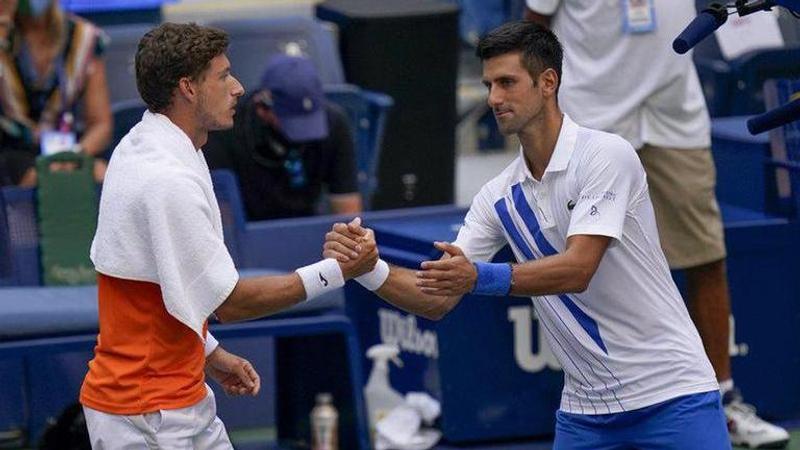Published 10:28 IST, September 8th 2020
Handshakes at US Open rare but, as Djokovic shows, do happen
Carreo Busta didn't hesitate after Sunday's stunning default to grasp Djokovic's hand that is, after all, the standard way tennis players show sportsmanship

When he was disqualified from the U.S. Open for unintentionally hitting a line judge with a ball after losing a point, Novak Djokovic walked to the sideline and extended his right arm toward his fourth-round foe, Pablo Carreo Busta.
Carreo Busta didn't hesitate after Sunday's stunning default to grasp Djokovic's hand that is, after all, the standard way tennis players show sportsmanship and mutual respect at the end of a match, usually at the net.
Standard in normal times, anyway. Less so in today's socially distanced, coronavirus-compromised world, where the customary has become taboo. So handshakes and hugs are few and far between at the U.S. Open even as NHL playoff series still are ending with the traditional handshake lines and walkoff wins and a no-hitter in Major League Baseball inspired full-contact celebrations reminiscent of the good ol' days.
You've spent your whole career doing things one way, said two-time major finalist Kevin Anderson, a South African.
But we have to make an adjustment. It's obviously indicative of much larger things at play.
So over these unique two weeks at Flushing Meadows -- where there is regular on-site COVID-19 testing, spectators are banned, masks are required for everyone except when eating, and players have to fetch their own towels during matches the popular replacement gesture at match's end is a racket tap.
The point gets across, said Jessica Pegula, a 63rd-ranked American who reached the third round.
Generally, one player holds the racket vertically, with the strings facing the winner, who then touches that waiting racket face with the edge of the frame.
That doesn't resolve how to replace a handshake with the chair umpire after a match; some players use their racket to pat one of the official's shoes.
It's quite different from the human contact that likely followed just about every match every U.S. Open entrant ever has played, whether as kids in a public park or as well-paid pros on the Grand Slam stage.
For me, it's actually fine, said Elise Mertens, a Belgian seeded 16th and scheduled to face Australian Open champion Sofia Kenin on Monday.
I mean, that's the circumstances we are dealing with. So I'm trying to adapt. Everybody's trying to adapt.
Denis Shapovalov, the 12th-seeded Canadian who will face Carreo Busta in the quarterfinals, found the whole thing a little bit strange, and Tennys Sandgren, an American who lost in Week 1, called it just not the same. Some find it harder than others to shake off the instinct to shake.
When Frances Tiafoe a 22-year-old who grew up in Maryland and was to play 2019 U.S. Open runner-up Daniil Medvedev on Monday played his first match after tennis resumed from its virus-forced hiatus, he and opponent Andy Murray each extended an arm over the net.
They avoided touching hands but wound up caught somewhere between a fist bump and a forearm smash.
We didn't know what to do. It was an awkward moment, Tiafoe said in an interview after that match at the Western & Southern Open, held last month at the same site as the U.S. Open. Everyone's trying to figure it out and get used to it. Apparently, Tiafoe still is trying.
When he reached the fourth round at Flushing Meadows for the first time by beating his pal Marton Fucsovics of Hungary 6-2, 6-3, 6-2 on Saturday, Tiafoe went ahead and reached out to clasp hands up at the net. Fucsovics responded in kind, and they both then tapped the other on the chest.
I was a bit surprised, Fucsovics said.
But I am good friends with Frances. I hope he doesn't have COVID-19 and we won't have any problems.
Well, as it happens, Tiafoe did test positive for the coronavirus in July while participating in an exhibition event in Atlanta and had to withdraw. Tiafoe said he felt bad for four or five days but doesn't have any after-effects now.
Last week in New York, a pair of Americans so close away from the court that each attended the other's wedding, No. 16 seed John Isner and Steve Johnson, shook hands after Johnson won in a fifth-set tiebreaker.
Yeah, I'll probably get defaulted for that. Got to be careful, Johnson joked, then explained precisely what went through his mind as he walked to the net after the 3-hour, 50-minute encounter: I feel like a racket tap at the end of that doesn't do it justice. No need to worry about being punished, Steve.
The U.S. Tennis Association did not institute any sort of formal policy or rule governing post-match interactions, even if there are signs around the Billie Jean King National Tennis Center that say, We're Back! But hugging isn't. Some ways to say hello: virtual hugs; quick elbow taps. Please avoid: hugs; fist bumps.
This is something that has become part of normal interaction and has carried over onto the court, USTA spokesman Brendan McIntyre said.
There would be no penalty or fine for shaking hands.
Image credits: AP
Updated 10:28 IST, September 8th 2020




